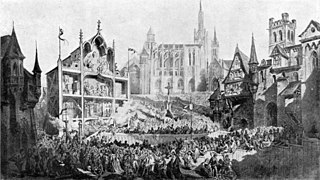
Mystery plays and miracle plays are among the earliest formally developed plays in medieval Europe. Medieval mystery plays focused on the representation of Bible stories in churches as tableaux with accompanying antiphonal song. They told of subjects such as the Creation, Adam and Eve, the murder of Abel, and the Last Judgment. Often they were performed together in cycles which could last for days. The name derives from mystery used in its sense of miracle, but an occasionally quoted derivation is from ministerium, meaning craft, and so the 'mysteries' or plays performed by the craft guilds.

Trapani is a city and municipality (comune) on the west coast of Sicily, in Italy. It is the capital of the Province of Trapani. Founded by Elymians, the city is still an important fishing port and the main gateway to the nearby Egadi Islands.
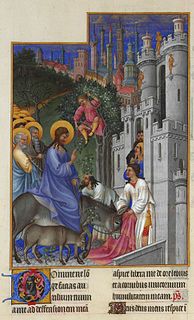
In some traditions of Christianity, Holy Week is the most sacred week in the Church year. In Eastern Rite Churches, also known as Eastern Orthodox, Holy Week occurs the week after Lazarus Saturday and starts on the evening of Palm Sunday. In the rites of the Western/Latin/Roman Church it begins with Palm Sunday and concludes on Easter Sunday. For all Christian traditions it is a moveable observance. In Eastern Rite Churches, Holy Week starts after 40 days of Lent and two transitional days, namely Saturday of Lazarus and Palm Sunday. In Western Rite Churches, Holy Week falls on the last week of Lent or Sixth Lent Week.
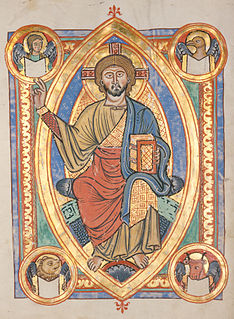
The Stations of the Cross or the Way of the Cross, also known as the Way of Sorrows or the Via Crucis, refers to a series of images depicting Jesus Christ on the day of his crucifixion and accompanying prayers. The stations grew out of imitations of Via Dolorosa in Jerusalem which is believed to be the actual path Jesus walked to Mount Calvary. The objective of the stations is to help the Christian faithful to make a spiritual pilgrimage through contemplation of the Passion of Christ. It has become one of the most popular devotions and the stations can be found in many Western Christian churches, including Anglican, Lutheran, Methodist, and Roman Catholic.
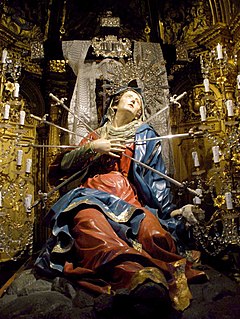
Our Lady of Sorrows, Our Lady of Dolours, the Sorrowful Mother or Mother of Sorrows, and Our Lady of Piety, Our Lady of the Seven Sorrows or Our Lady of the Seven Dolours are names by which the Virgin Mary is referred to in relation to sorrows in her life. As Mater Dolorosa, it is also a key subject for Marian art in the Catholic Church.

The Misterio de Elche, in English the Mystery Play of Elche or Elche Mystery Play and in Catalan Misteri d'Elx, is a liturgical drama from the Middle Ages that reenacts the Dormition and Assumption of the Blessed Virgin Mary.

Holy Week in Seville is known as Semana Santa de Sevilla. It is one of the city’s two biggest annual festivals, the other being the Feria de Abril, which follows two weeks later. It is celebrated in the week leading up to Easter, and features the procession of pasos, floats of lifelike wooden sculptures of individual scenes of sorrowful Mysteries of the Rosary, or images of the grieving Virgin Mary.

Christ Carrying the Cross on his way to his crucifixion is an episode included in all four Gospels, and a very common subject in art, especially in the fourteen Stations of the Cross, sets of which are now found in almost all Catholic churches. However, the subject occurs in many other contexts, including single works and cycles of the Life of Christ or the Passion of Christ. Alternative names include the Procession to Calvary, Road to Calvary and Way to Calvary, Calvary or Golgotha being the site of the crucifixion outside Jerusalem. The actual route taken is defined by tradition as the Via Dolorosa in Jerusalem, although the specific path of this route has varied over the centuries and continues to be the subject of debate.

The Museo Nacional de San Gregorio is a museum in Valladolid, Spain, belonging to the Spanish Ministry of Culture. The museum has an extensive collection sculptural ranging from the Middle Ages to the 19th century from Region of Castile's churches that, at 19th-20th c., these were confiscated, and other particular donations, deposits or acquisitions of the state.

Holy Week in Spain is the annual tribute of the Passion of Jesus Christ celebrated by Catholic religious brotherhoods and fraternities that perform penance processions on the streets of almost every Spanish city and town during the last week of Lent, the week immediately before Easter.
Holy Week in the Philippines is a significant religious observance for the country's Catholic majority, the Iglesia Filipina Independiente or the Philippine Independent Church and most Protestant groups. One of the few majority Christian countries in Asia, Catholics make up 80 percent of the population, and the Church is one of the country's dominant sociopolitical forces.
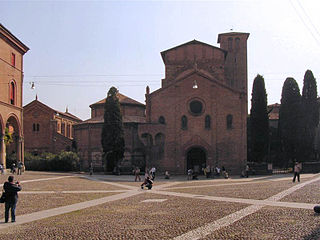
The basilica of Santo Stefano encompasses a complex of religious edifices in the city of Bologna, Italy. Located on Piazza Santo Stefano, it is locally known as Sette Chiese and Santa Gerusalemme. It has the dignity of minor basilica.
La Cercha is a liturgical drama that takes the Holy Friday, in Collesano, province of Palermo (Sicily). It was staged for the first time 1667.
The Holy Week in Braga is the most imposing, attractive and famous among all in Portugal, and the most important tourist and religious event in the city of Braga. It is estimated that about 100.000 people attend the major processions. It combines harmoniously elements of the liturgy and of popular piety, ancient traditions and innovation. Since November 2011, this event is officially “Declared of Interest to Tourism”.
The Penitential Brotherhood of the Holy Eucharist, founded on May 6, 1959, is one of nine religious brotherhoods of the city of Bilbao that take part in its Holy Week. Bilbao is the most important place for the Holy Week in Spain in the northern part of the country, but not as well known as the Holy Week in Seville. It is canonically headquartered at the Jesuit School, so it is popularly known as the Jesuit Brotherhood. It consists of current and former students, as well as family and friends, but also of people outside the school.

The Illustrious Brotherhood of the Holy Cross of the Redeemer and the Immaculate Conception, his Mother, known as the Vera Cruz or True Cross is a Catholic fraternity established in Salamanca, Castile and León, Spain in 1506.
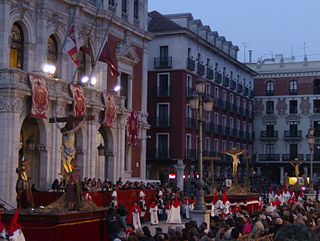
The Holy Week in Valladolid is one of the main tourist attractions, and cultural and religious events of Valladolid and the surrounding province during Holy Week in Spain. It boasts of renowned polychrome sculptures, created mainly by sculptors such as Juan de Juni and Gregorio Fernández, who were active when the city served as the imperial court. The city's National Sculpture Museum has a total of 42 images for the processions. The Holy Week in Valladolid is known to depict the Passion with great fidelity, rigor and detail.

Our Lady of Miracles is the patron saint of the town of Alcamo.

Holy Week in Málaga, is the annual commemoration of the Passion of Jesus in Málaga, Spain. It takes place during the last week of Lent, the week immediately before Easter. It is one of the city's main cultural and religious events.

Santa Maria dello Stellario was a catholic Church located in piazza Ciullo, in the town centre of Alcamo, in the province of Trapani.

















